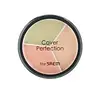NYX Cosmetics Color Correcting Concealer Palette Versus The Saem Cover Perfection Triple Pot Concealer
What's inside
What's inside
 Key Ingredients
Key Ingredients

 Benefits
Benefits

 Concerns
Concerns

 Ingredients Side-by-side
Ingredients Side-by-side

Trimethylsiloxyphenyl Dimethicone
Dimethicone
EmollientBeeswax
Emulsion StabilisingIsononyl Isononanoate
EmollientCaprylic/Capric Triglyceride
MaskingOctyldodecanol
EmollientPolyglyceryl-3 Diisostearate
EmulsifyingPolyethylene
AbrasiveSorbitan Olivate
EmulsifyingDimethicone Crosspolymer
Emulsion StabilisingHydrogenated Microcrystalline Wax
Emulsion StabilisingTocopheryl Acetate
AntioxidantTriethoxycaprylylsilane
BHT
AntioxidantMica
Cosmetic ColorantCI 77891
Cosmetic ColorantCI 77492
Cosmetic ColorantCI 42100
Cosmetic ColorantCI 75470
Cosmetic ColorantCI 77288
Cosmetic ColorantCI 19140
Cosmetic ColorantIron Oxides
Trimethylsiloxyphenyl Dimethicone, Dimethicone, Beeswax, Isononyl Isononanoate, Caprylic/Capric Triglyceride, Octyldodecanol, Polyglyceryl-3 Diisostearate, Polyethylene, Sorbitan Olivate, Dimethicone Crosspolymer, Hydrogenated Microcrystalline Wax, Tocopheryl Acetate, Triethoxycaprylylsilane, BHT, Mica, CI 77891, CI 77492, CI 42100, CI 75470, CI 77288, CI 19140, Iron Oxides
CI 77891
Cosmetic ColorantCaprylic/Capric Triglyceride
MaskingPolyisobutene
Mica
Cosmetic ColorantIsodecyl Neopentanoate
EmollientDiisostearyl Malate
EmollientHydrogenated Castor Oil
EmollientDipentaerythrityl Hexahydroxystearate/Hexastearate/Hexarosinate
Skin ConditioningMethyl Methacrylate Crosspolymer
Butyloctyl Salicylate
Skin ConditioningCI 77492
Cosmetic ColorantParaffin
PerfumingAluminum Hydroxide
Emollient1,2-Hexanediol
Skin ConditioningSorbitan Sesquioleate
EmulsifyingMicrocrystalline Wax
Emulsion StabilisingCI 77491
Cosmetic ColorantMethicone
EmollientCI 77499
Cosmetic ColorantCaprylyl Glycol
EmollientSqualane
EmollientParfum
MaskingPrunus Amygdalus Dulcis Oil
Skin ConditioningWater
Skin ConditioningBHT
AntioxidantButylene Glycol
HumectantAspalathus Linearis Leaf Extract
Skin ConditioningThymus Vulgaris Extract
PerfumingFoeniculum Vulgare Leaf Extract
HumectantLinalool
PerfumingLimonene
PerfumingHexyl Cinnamal
PerfumingTitanium Dioxide
Cosmetic ColorantCI 77288
Cosmetic ColorantAlpha-Isomethyl Ionone
PerfumingCI 77891, Caprylic/Capric Triglyceride, Polyisobutene, Mica, Isodecyl Neopentanoate, Diisostearyl Malate, Hydrogenated Castor Oil, Dipentaerythrityl Hexahydroxystearate/Hexastearate/Hexarosinate, Methyl Methacrylate Crosspolymer, Butyloctyl Salicylate, CI 77492, Paraffin, Aluminum Hydroxide, 1,2-Hexanediol, Sorbitan Sesquioleate, Microcrystalline Wax, CI 77491, Methicone, CI 77499, Caprylyl Glycol, Squalane, Parfum, Prunus Amygdalus Dulcis Oil, Water, BHT, Butylene Glycol, Aspalathus Linearis Leaf Extract, Thymus Vulgaris Extract, Foeniculum Vulgare Leaf Extract, Linalool, Limonene, Hexyl Cinnamal, Titanium Dioxide, CI 77288, Alpha-Isomethyl Ionone
 Reviews
Reviews

Ingredients Explained
These ingredients are found in both products.
Ingredients higher up in an ingredient list are typically present in a larger amount.
BHT is a synthetic antioxidant and preservative.
As an antioxidant, it helps your body fight off free-radicals. Free-radicals are molecules that may damage your skin cells.
As a preservative, it is used to stabilize products and prevent them from degrading. Specifically, BHT prevents degradation from oxidation.
The concerns related to BHT come from oral studies; this ingredient is currently allowed for use by both the FDA and EU.
However, it was recently restricted for use in the UK as of April 2024.
Learn more about BHTThis ingredient is an emollient, solvent, and texture enhancer. It is considered a skin-softener by helping the skin prevent moisture loss.
It helps thicken a product's formula and makes it easier to spread by dissolving clumping compounds.
Caprylic Triglyceride is made by combining glycerin with coconut oil, forming a clear liquid.
While there is an assumption Caprylic Triglyceride can clog pores due to it being derived from coconut oil, there is no research supporting this.
Learn more about Caprylic/Capric TriglycerideCi 77288 is used to add green pigment to products.
Ci 77492 is also hydrated iron III oxide. It's sole purpose is to give a yellow hue to products.
Iron III oxides are classified as inorganic chemicals for coloring.
Synthetically created Ci 77492 is considered safer than those naturally found. This is because the synthetically created version may contain less impurities. Iron oxides are generally non-toxic and non-allergenic.
Learn more about CI 77492Ci 77891 is a white pigment from Titanium dioxide. It is naturally found in minerals such as rutile and ilmenite.
It's main function is to add a white color to cosmetics. It can also be mixed with other colors to create different shades.
Ci 77891 is commonly found in sunscreens due to its ability to block UV rays.
Learn more about CI 77891Mica is a naturally occurring mineral used to add shimmer and color in cosmetics. It can also help improve the texture of a product or give it an opaque, white/silver color.
Serecite is the name for very fine but ragged grains of mica.
This ingredient is often coated with metal oxides like titanium dioxide. Trace amounts of heavy metals may be found in mica, but these metals are not harmful in our personal products.
Mica has been used since prehistoric times throughout the world. Ancient Egyptian, Indian, Greek, Roman, Aztec, and Chinese civilizations have used mica.
Learn more about Mica